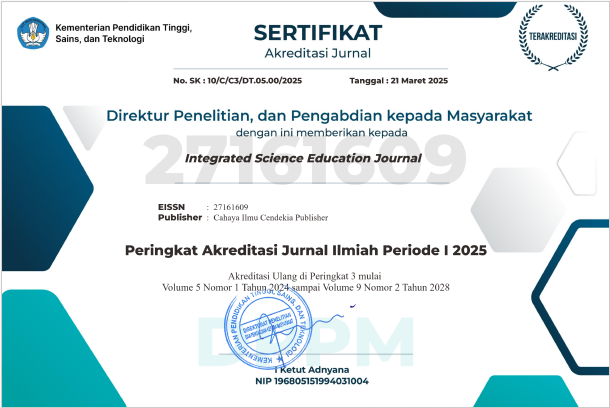The Effect of Problem Based Learning (PBL) Model Based on Local Wisdom to Improve Students' Critical Thinking Skills
Abstract
Purpose of the study: The purpose of this study was to determine the effect of problem-based learning (PBL) model based on local wisdom in making lemang kancung beruk to improve students' critical thinking skills.
Methodology: The research method is a quasi-experimental form of non-equivalent pretest-posttest control group design with non-probability sampling technique-purposive sampling. The data collection techniques used critical thinking skills tests with FRISCO indicator essay tests and observation sheets. Technical data analysis used Analysis of covariance (Ancova) test and quantitative descriptive approach used SPSS 20 program.
Main Findings: The research results of the Ancova hypothesis test show that the corrected model sig value is 0.000 <0.05, then H0 is rejected and H1 is accepted, This means that the problem-based learning (PBL) model based on local wisdom in making lemang kancung beruk has a significant and moderate effect on improving students' critical thinking skills.
Novelty/Originality of this study: The novelty of this research is the implementation of problem-based learning (PBL) model based on local wisdom of Kerinci-Sungai Penuh area in science learning. The limitations in the study are the competencies measured in the integrated essay test and the subject matter is the science material of substances and their changes in class VII.
References
R. Husain and A. Kaharu, “Facing the 21st Century: Challenges for Early Childhood Education Teachers in Bone Bolango District,”Jurnal Obsesi : Jurnal Pendidikan Anak Usia Dini, vol. 5, no. 1, pp. 85–92, May 2021, doi: 10.31004/obsesi.v5i1.527.
F. Kiraga, “Literature Review: Efforts To Improve Creative Thinking Ability In Science Learning,” Integrated Science Education Journal, vol. 4, no. 2, pp. 77–83, May 2023, doi: 10.37251/isej.v4i2.330.
S. Senjawati, “The Classroom Teacher's Role in Improving Students' Understanding of Science Learning through Ethnoscience-Based Learning”. Integrated Science Education Journal, vol. 1, no. 2, pp. 46–50, May 2020, doi: 10.37251/isej.v1i2.78.
E. A. M. Castro, “Analysis of Problem Solving Ability of First Middle School Students in Learning Science,” Integrated Science Education Journal, vol. 4, no. 2, pp. 43–53, May 2023, doi: 10.37251/isej.v4i2.329.
N. Nurdeni, Y. B. Bhakti, E. Alfin, G. Marhento, and P. Purwanti, “Ability of Junior High School Students with Ethnoscience Learning,” Jurnal Pendidikan dan Konseling, vol. 4, no. 3, pp. 9779–9807, 2022. doi: 10.31004/jpk.v4i3.2343.
F. P. N. Fahrozy, D. M. Irianto, and D. T. Kurniawan, “Ethnoscience as a Contextual and Environmental Learning Effort for Primary School Learners,” Edukatif : Jurnal Ilmu Pendidikan, vol. 4, no. 3, pp. 4337–4345, May 2022, doi: 10.31004/edukatif.v4i3.2843.
B. Trilling and C. Fadel, Partnership for 21st Century Skills , 1st ed. United Stated of Amerika: Jossey Bass, 2012.
S. Zubaidah, “21st Century Skills: How to Teach and Assess them,” Biology Education FKIP Riau Islamic University, 2018.. doi: 10.31004/reseach.v4i3.456.
R. A. Utami and S. Giarti, “The Effectiveness of Problem Based Learning (PBL) and Discovery Learning Models in View of Critical Thinking Skills of 5th Grade Students,” PeTeKa (Jurnal Penelitian Tindakan Kelas dan Pengembangan Pembelajaran), vol. 3, no. 1, pp. 1–8, 2020, doi: 10.31604/ptk.v3i1.1-8.
T. P. Astuti, “Problem Based Learning Model with Mind Mapping in 21st Century Science Learning,” Proceeding of Biology Education, vol. 3, no. 1, pp. 64–73, Sep. 2019, doi: 10.21009/pbe.3-1.9.
K. Hadi, D. Dazrullisa, H. Hasruddin, and B. Manurung, “The Effect of Teaching Materials Based on Local Value Integrated by Character Education through PBL Models on Students’ High Order Thinking Skill,” Britain International of Humanities and Social Sciences (BIoHS) Journal, vol. 1, no. 2, pp. 213–223, Oct. 2019, doi: 10.33258/biohs.v1i2.54.
K. S. Avitrananda, M. Kusuma, and M. A. Fatkhurrohman“Implementation of Problem Based Learning Based on Local Wisdom of Kaligua Tea Plantation in Improving Students' Critical Thinking Ability,” JPMP: Jurnal Pendidikan MIPA Pancasakti, vol. 4, no. 2, pp. 114–122, 2020, doi: 10.31604/jpmp.v3i1.2345.
J. Mutiara and L. Fridayati, “A Study of Lemang Kancung Beruk in Dusun Baru Village, Lempur, Kerinci Regency,” Jurnal Pendidikan Tata Boga dan Teknologi, vol. 3, no. 1, pp. 75–80, 2022, doi: 10.2403/80sr379.00.
A. Helida, Z. EAM, H. Hardjanto, Y. Purwanto, and A. Hikmat, “The Ethnography of Kerinci,” KOMUNITAS: International Journal of Indonesian Society and Culture, vol. 7, no. 2, pp. 283–296, 2015, doi: 10.15294/komunitas.v7i2.4837.
N. Lestariningsih and D. Setyaningsih, “Explorative study of tropical pitcher plants (Nepenthes sp.) types and insects that trapped inside in Sebangau National Park Palangka Raya Central Kalimantan,” in Journal of Physics: Conference Series, Institute of Physics Publishing, 2017. doi: 10.1088/1742-6596/795/1/012062.
E. S. Sari and Hudaidah, “Eid Traditions in Kemang Village, Musi Banyuasin Regency, South Sumatra,” JURNAL SAMBAS (Studi Agama, Masyarakat, Budaya, Adat, Sejarah), vol. 3, no. 2, pp. 172–180, 2021, doi: 10.15674/sambas.v7i2.4567
R. H. Ennis, The Nature of Critical Thinking : An Outline of Critical Thinking Dispositions and Abilities. Champaign University of Illinois, 2011.
H. Hair, A. Anderson, T. Tatham, and B. Black, Multivariate Data Analysis, Fifth Edition. NewJersey: Prentice-Hall International, Inc., 1998.
N. Putri, “The Effect of Problem Based Learning Model on Students' Critical Thinking Ability in Economics Class XI IIS at SMAN 3 Surabaya,” JUPE, vol. 6, no. 3, pp. 236–241, 2018, doi: 10.236/jupe.v7i2.347.
L. Cohen, L. Manion, and K. Morrison, Research methods in education. New York: Taylor & Francis Group, 2002, doi: 10.4324/9780203224342
L. S. Sari, J. Jonata, and P. Handayani, “Implementation of Local Wisdom Problem Based Learning Model to Improve Critical Thinking Ability of Elementary / MI Students,” Journal of Innovation Research and Knowledge, vol. 1, no. 9, pp. 841–847, 2022, doi: 10.56997/kurikula.v7i1.706
I. K. Mahardika, N. N. Izza, W. Dharmawan, and A. L. Nisa, “The Effect of Practicum-Based Problem Based Learning (PBL) Learning Model on Critical Thinking Ability of Class VIII Students in Science Learning at SMPNegeri 9 Jember,” Jurnal Ilmiah Wahana Pendidikan, vol. 8, no. 24, pp. 393–399, 2022, doi: 10.5281/zenodo.7494501.
S. Kartika, M. Muhaimin, and Z. Zurweni, “The Implementation and Effect of Problem-Based Learning Based on Local Wisdom Toward Students’ Communication and Critical Thinking Abilityon Temperature and Heat Topic,” JPPPF (Jurnal Penelitian danPengembangan Pendidikan Fisika), vol. 8, no. 1, pp. 165–174, 2022, doi: 10.21009/1.
H. Hardiantiningsih, S. Istiningsih, and Hasnawati, “The Effect of Problem Based Learning (PBL) Learning Model on Students' Critical Thinking Ability,” Journal of Classroom Action Research, vol. 5, no. 2, pp. 297–303, 2023, doi: 10.29303/jcar.v5i2.3737.
N. Fadilla, L. Nurlaela, T. Rijanto, S. R. Ariyanto, L. Rahmah, and S. Huda, “Effect of problem-based learning on critical thinking skills,” in Journal of Physics: Conference Series, IOP Publishing Ltd, Mar. 2021, pp. 1–5. doi: 10.1088/1742-6596/1810/1/012060.
S. F. Nur, F. Arsih, M. Fadillah, and R. Anggriyani, “The Effect of the Application of Problem Based Learning (PBL) Learning Model with Ethnoscience Approach on Critical Thinking Skills of Students on Environmental Change Material,” Jurnal Pendidikan Tambusai, vol. 7, no. 2, pp. 16312–16322, 2023, doi: 10.16322/tambusai.v3i2.632
D. B. Cahyono, C. Roini, and M. N. Tamalene, “Habitat Characteristics of Semar Pockets (Nepenthes sp) on Halmahera Island,” Techno: Jurnal Penelitian, vol. 8, no. 1, pp. 233–241, Sep. 2019, doi: 10.33387/tk.v8i1.1089.
L. Lidiawati, I. D. Pursitasari, and L. Heliawati, “Critical Thinking Skills and Self-Regulated Learning Of Students during the Covid-19 Pandemic,” EduChemia (Jurnal Kimia dan Pendidikan), vol. 7, no. 1, p. 1, Jan. 2022, doi: 10.30870/educhemia.v7i1.10627.
D. S. Setiana, N. Nuryadi, and R. Santosa “Analysis of Mathematical Critical Thinking Ability in Terms of Overview,” JKPM (Jurnal Kajian Pendidikan Matematika), vol. 6, no. 1, pp. 1–12, 2020. https://doi.org/10.30998/jkpm.v6i1.6483
S. Mariam, Rusmansyah, and M. Istyadji, “Improving Critical Argumentation Skills And Self Efficacy Of Students With Inquiry Based Learning Models In Materials Of Buffer Solution,” Journal of Chemistry And Education, vol. 3, no. 2, pp. 64–73, 2019, doi: 10.20527/jcae.v3i2.341
E. Destianingsih, A. Pasaribu, and I. Ismet, “The Effect of Problem Based Learning Model on Students' Problem Solving Ability in Physics Learning Class XI at SMA Negeri 1 Tanjung Lubuk,” Jurnal Inovasi dan Pembelajaran Fisika, vol. 3, no. 1, pp. 15–21, 2016.
Copyright (c) 2024 Sri Anika Cahayu, Jodion Siburian, Afreni Hamidah

This work is licensed under a Creative Commons Attribution 4.0 International License.
Authors who publish with this journal agree to the following terms:
- Authors retain copyright and acknowledge that the Integrated Science Education Journal is the first publisher licensed under a Creative Commons Attribution 4.0 International License.
- Authors are able to enter into separate, additional contractual arrangements for the non-exclusive distribution of the journal's published version of the work (e.g., post it to an institutional repository or publish it in a book), with an acknowledgment of its initial publication in this journal.
- Authors are permitted and encouraged to post their work online (e.g., in institutional repositories or on their website) prior to and during the submission process, as it can lead to productive exchanges and earlier and greater citation of published work.







.png)
.png)






